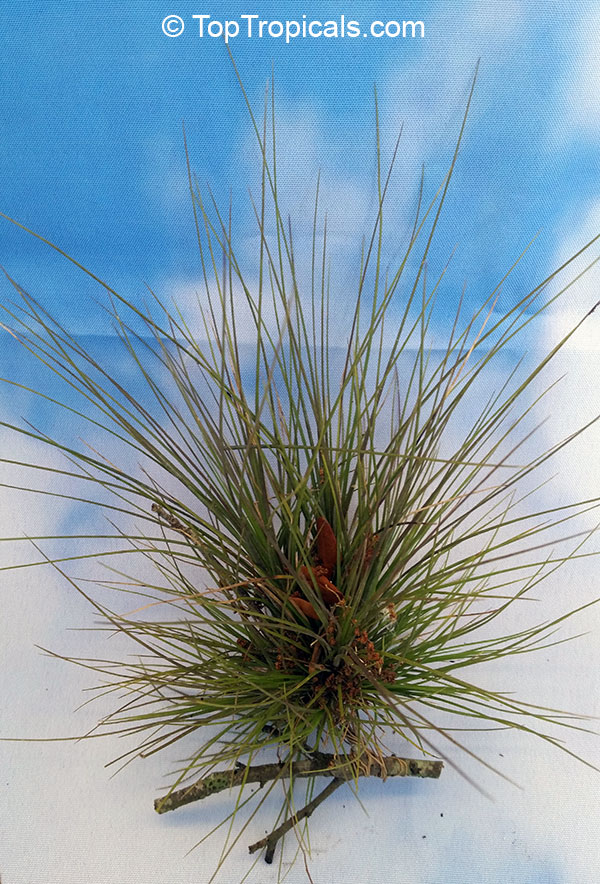Tillandsia x disticha - Airplant
4713 Tillandsia x disticha - Airplant








Tillandsias, called by some the world's most unusual airplants, are a delightful addition to any greenhouse. They are easy to care for, exotic to look at, and interesting to study. Tillandsias have developed the ability to take all their food and water through specially designed cells on their leaves and therefore can exist without any roots for ever. Roots are used by most species to attach themselves and nothing more. Tillandsias can grow in places no other plants can survive including electrical cable on power lines. They prefer light airy conditions and daily misting in areas of low humidity.
Kept as a houseplant, Tillandsias can be added to a glass terrarium or a sea shell planter. They are commonly attached to a piece of wood or hung from a wire air plant display. Can also be grown in containers if you use orchid mix.
Recommended Fertilizer: SUNSHINE Ananas - Pineapple and Bromeliad Booster
SUNSHINE-Honey - sugar booster
SUNSHINE-Superfood - micro-element booster
Last one
See picture of actual plants for sale
Tillandsia x disticha - Airplant: Planting and Care Instructions
Plant Overview
Growth habit: This is a small herbaceous plant, growing between 2 and 5 feet. It is great for flower beds, pots, or small garden spots.
Growing conditions: This plant can be grown outdoors in suitable USDA zones. It is well-suited for small backyards, pots, or indoor spaces with enough light.
Watering: This plant requires regular watering. Water it when the top layer of soil begins to dry out.
Sun exposure: This plant prefers semi-shade. It grows well in places that get filtered sunlight or partial sun during the day.
USDA Zone: USDA 9-11. The USDA Plant Hardiness Zone Map categorizes North America into zones based on average annual minimum winter temperatures, each differing by 10 °F. This map serves as a basic guide for selecting appropriate plants for a region. However, it's not definitive; plant varieties vary in cold tolerance, and young plants typically need more protection. Additionally, local microclimates, like sheltered areas or sunny spots, can influence plant health and survivability beyond the general zone recommendation.
Hardiness: Protect from freezing. Plant hardiness indicates the coldest temperature a mature plant can endure briefly while staying healthy. This rating is a guideline and can vary among varieties of the same species. Young plants often need more cold protection. Additionally, a plant's survival can be enhanced by the microclimate of its location, which may provide shelter from wind or extra warmth, allowing it to thrive beyond its typical hardiness range.
Flower color: This plant produces pink, white and off-white, red, crimson, or vinous, and yellow or orange flowers during its blooming season.
Outdoor planting
Select a planting spot that fits the plant sun and moisture needs. Loosen the soil and mix in compost or organic matter to improve poor soil. Dig a hole just slightly larger than the root ball and avoid planting deeper than it was before. For better drainage, the top of the root ball can sit slightly above the surrounding soil. Provide temporary shade at first if conditions are hot or sunny. Water regularly and monitor soil moisture until the plant is well rooted. nAdd mulch around the base to keep the soil moist and reduce weeds. Shape the mulch to form a shallow basin for water, but keep mulch away from the stem.
Indoor planting
Use a container with drainage holes and a well-draining potting mix. Position the plant so that the top of the root ball is level with the surface of the soil - avoid planting too deep. A slow-release fertilizer can be mixed into the soil at planting time to support healthy growth. Place the plant in a location that matches its light needs, and water according to its care requirements. Be careful not to overwater, and ensure good airflow around the plant to reduce the risk of pests and disease.
Protecting Plants in Winter
When it gets cold, some plants need extra help. You can move potted plants indoors or under a covered patio. Young plants need extra protection because they are more sensitive to cold and less established. For plants in the ground, use frost cloth to keep them warm. Stop using fertilizer in late fall so plants can rest. Try to place plants in areas protected from cold wind, rain, and frost.
Cold Hardiness and Microclimates
USDA zone and hardiness are only general guidelines. Actual cold tolerance can vary based on plant variety and local conditions. Even small differences between varieties can matter. Also, warmer spots in your yard—like near a wall or fence—can help plants survive cold nights. These little warm areas are called microclimates, and they make a big difference.
